Faculty Syllabus: Electrocardiography II- Hypertrophy and Enlargement
ECG II: Hypertrophy and Enlargement
John E. Rush, DVM, MS, DACVIM (Cardiology), DACVECC
Cummings School of Veterinary Medicine at Tufts University
OBJECTIVES
– List stimuli for physiologic and pathophysiologic cardiac hypertrophy. Describe the cellular changes and gross morphologic differences with eccentric vs. concentric hypertrophy. Be able to explain, using the Law of LaPlace, how myocardial hypertrophy alters wall tension.
– List ECG criteria and be able to identify ECG enlargement patterns of left atrial enlargement (P mitrale), right atrial enlargement (P pulmonale), left ventricular enlargement, and right ventricular enlargement in the dog and the cat.
– Identify electrocardiographic patterns for axis deviation (right axis deviation, left axis deviation) and bundle branch blocks (right bundle branch block, left bundle branch block and left anterior fascicular block).
– *** Includes especially important concepts
ELECTROCARDIOGRAPHY II
Hypertrophy/Enlargement and Bundle Branch Block
Physiology/pathophysiology, biochemistry, pathology of cardiac hypertrophy
1. Established causes of cardiac hypertrophy include:
a. postnatal growth
b. increased workload (increased preload/afterload)
c. ischemia/injury to myocardium
d. hereditary factors
e. hypothermia
f. increased circulating/local levels of catecholamines
g. increased circulating/local levels of angiotensin II levels
h. pregnancy
i. exercise
j. anemia
k. hyperthyroidism
l. Many diseases

2. A stimulus for hypertrophy of cardiac muscle in cases of increased preload (volume overload; ex. mitral insufficiency) and/or increased afterload (pressure overload; ex. aortic stenosis, systemic hypertension) is thought to be an increase in wall stress (tension). ***
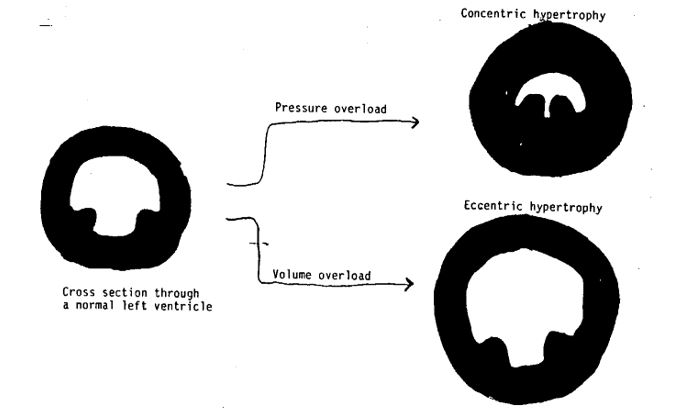
a. A chain of events is set into motion that results in compensation (a decrease towards normal of s). This process involves hypertrophy of the cardiac muscle, and this increase in wall thickness results in a diminution of wall tension according to the physical principles defined in the Law of LaPlace. ***

b. In the event that the cellular/subcellular compensatory mechanisms are unable to completely counteract an increase in wall stress, induced by an incompetent valve, stenotic valve or otherwise injured myocardium, a progressive process eventually resulting in myocardial failure may result.
c. The stimulus for cardiac hypertrophy is complex, is not always triggered exclusively by wall stress, and may be related to catecholamines, angiotensin, ischemia, an upset in the balance in energy (ATP) production and utilization, and many other factors.
– Individual myocytes undergo morphologic change soon after the stimuli for hypertrophy are encountered. This is associated with some increase in the number of nuclei/cell, increase in the sarcomere numbers and some longitudinal splitting of myocytes. Early and progressive increase in interstitial tissue (fibrosis) is associated with certain diseases that cause myocardial hypertrophy.
– Physiologic studies demonstrated that hypertrophy of the myocardium is associated with a depressed force-generating capacity per unit cross section of myocardium at any given muscle length, but that hypertrophied myocardium has a greater than normal overall force-generating capacity due to an increased number of weaker cross-sectional units.
3. The exact biochemical/subcellular pathogenesis of pathologic cardiac hypertrophy are complex.
4. The specific response of the myocardium to increased stress is determined in large part by the nature of the added work load that is present. These will be discussed further as they relate to increased workloads imposed upon the left ventricle. However, it should be understood that similar changes can and do occur in the right ventricle when cardiovascular disorders have a predominant effect on the right side of the heart.
a. Concentric hypertrophy ***
– Increased afterload (i.e. aortic or subaortic stenosis, systemic hypertension or increased systemic vascular resistance).
– Enlargement is primarily due to an increase in the size, particularly the width of the fibers. There is some evidence using election microscopy that hypertrophy is accompanied by both splitting and addition of sarcomeres in parallel.
– Increased O2 consumption
– Beneficial effects
-Total force may be increased as a result of a greater muscle mass.
– Increased ejection fraction.
b. Eccentric hypertrophy (dilatation) ***
– Increased preload (i.e. intra- and extracardiac shunts, aortic insufficiency, mitral incompetence).
– Chamber enlargement is initiated by dilatation with secondary hypertrophy. Dilatation is associated with an increase in cell size and length, a rearrangement and shifting (i.e. “slippage”) of myofibrils within the myocardial cells and possibly an increase in the number of sarcomeres in series.
– Increased O2 consumption
– Beneficial effects
– Increased velocity and extent of myocardial fiber shortening
– Normal or increased ejection fraction
– Greater proportion of contractile energy is expended in shortening than in tension development
Electrocardiographic Alterations in Cardiac Enlargement/Hypertrophy
Clinical recognition of cardiac enlargement normally incorporates a good physical examination and a series of noninvasive diagnostic procedures. As a rule, thoracic radiography, electrocardiography and echocardiography are the procedures most useful in obtaining this information. However, each of these diagnostic procedures has certain inherent limitations which tend to reduce their usefulness and in certain circumstances. An example of these limitations: In patients with concentric hypertrophy, the external size of the left ventricle on thoracic radiographs may be normal or minimally enlarged. However, the increased LV muscle mass that accompanies this condition usually can be identified by electrocardiography and echocardiography. On the other hand, when eccentric hypertrophy and its associated LV dilatation is present, thoracic radiography and electrocardiography are frequently able to identify its presence. The degree of cardiac enlargement or hypertrophy, patient cooperation and the presence of other intrathoracic processes (i.e. pleural effusion) may limit the diagnostic capabilities of each procedure.
The real value of electrocardiography lies in its capability of being able to provide quality information that cannot be obtained by other means. In addition to its usefulness in providing information regarding cardiac chamber enlargement/ hypertrophy, electrocardiography also can contribute the following: (1) identification of cardiac arrhythmias and conduction disturbances, (2) recognition of ventricular ischemia, (3) information regarding drug effect/toxicity and (4) insight to certain electrolyte abnormalities. In the discussion that follows, we will concentrate on the electrocardiographic recognition of cardiac enlargement/ hypertrophy. Unfortunately, due to differences between the activation process of Type A species (including dog cat and primates) vs. the extensive Purkinje fiber penetration in Type B species (hooved animals like horses, cattle), the evaluation of cardiac enlargement in the Type B animals is neither sensitive or specific, so the information that follows is only applicable to dogs and cats and primates.
Measurements are usually made from ECG tracings of lead II at 50 mm/sec paper speed with 1mV = 1cm
Atrial Enlargement
1. P pulmonale or Right Atrial Enlargement Pattern – PII: duration < 0.04 sec; amplitude > 0.4mV dogs, > 0.2mV cats. *** P pulmonale is associated with right atrial enlargement. In dogs it can also been seen with chronic respiratory disease. In some cats, with severe left atrial enlargement may have P pulmonale (right atrial enlargement pattern on ECG) instead of P mitral (left atrial enlargement pattern on ECG).
LEAD II, (50 mm/sec)

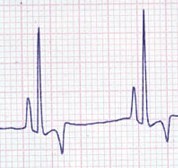
2. P mitrale or Left Atrial Enlargement Pattern- PII: duration > 0.04 sec; amplitude < 0.4mV dogs, < 0.2mV cats.*** Is associated with left atrial enlargement and called P mitrale since disease of the mitral valve is often associated with left atrial enlargement. There can be a notch associated with the widened P wave, especially in dogs.
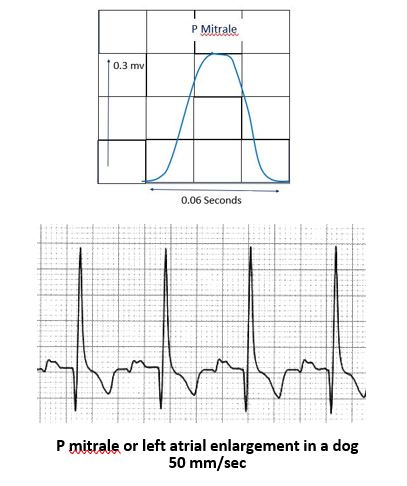
3. Biatrial enlargement – PII: duration > 0.04 sec; amplitude > 0.4mV dogs, 0.2mV cats (beware over interpretation of P mitrale)

Determination of mean frontal axis as means of assessing ventricular chamber enlargement Three different methods:
1. Look for isoelectric lead. Select the perpendicular lead. Determine if the QRS in the perpendicular lead is positive or negative. This is the direction of the mean electrical axis in the frontal plane.
2. Look for tallest R wave and select this as the mean electrical axis (this method is less specific).
3. Plot the algebraic sum of the QRS complex in leads I and III (see Tilley LP. Essentials of canine and feline electrocardiography, 2nd edition, p. 466).

The mean electrical axis is approximately 75 degrees in the above ECG from a normal dog. The chest leads are not used to calculate mean electrical axis in the frontal plane. The tallest R wave is lead II, indicating that the axis should be close to this lead (60 degrees). If you elected to pick aVL as the isoelectric lead, the lead II is 90 degree to this lead, and lead II is positive, so you would still get approximately 60 degrees. If you instead picked Lead I as the isoelectric lead then you would have looked to lead III as the perpendicular lead and calculated the mean electrical axis as 90 degrees. The true mean electrical axis is in between leads II and III, so approximately 75 degrees.
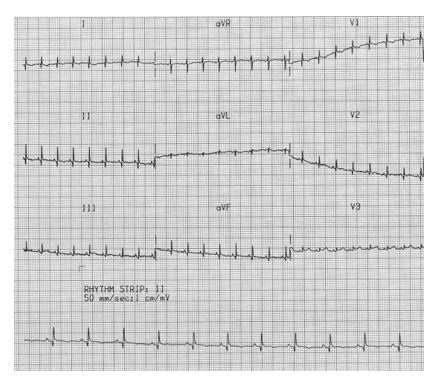
The mean electrical axis in this normal cat is more difficult to determine but is approximately 60 to 90 degrees. Leads I, avR, and aVL are all nearly isoelectric. Leads II, III, and aVF are mostly positive. I would have picked aVL as the most isoelectric, with the least overall deflection, and 90 degrees to this lead is Lead II. The almost exclusively positive QRS complex in lead III leads to consideration of an axis closer to 90 degrees. In this ECG, plotting the algebraic sums of the QRS deflections in Leads I and III results in a mean electrical axis of 76 degrees.
Ventricular Enlargement/Hypertrophy
Left ventricular enlargement in a dog

1. Left ventricular enlargement *** – Any or all of the following may be recorded.
a. In general, increased R wave amplitude in left-ward directed leads (i.e. I, II, III, aVF, V2, V4, V6), and/or
rolonged QRS interval duration – QRSII > 0.06 sec (> 0.07 sec in giant breed dogs; > 0.04 in cats).
Left axis deviation pattern may also be noted.
Secondary ST-T changes such as S-T segment repolarization changes, especially S-T segment depression, may be recorded. These findings suggest overlapping of the repolarization and depolarization processes and/or ischemic changes
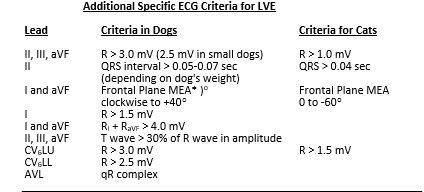
Left ventricular enlargement in a cat
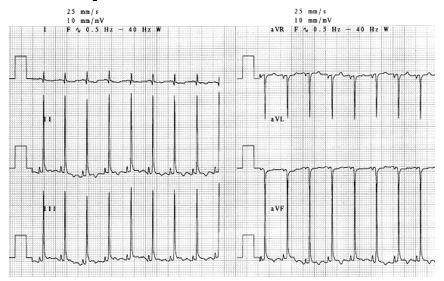
2. Right ventricular enlargement ***
a. Can be diagnosed with a low incidence of false-positive results in dogs when at least 3 of the following features are present:
– S wave in lead CV6LL greater than 0.8 mv (8 boxes)
– Mean electrical axis of the QRS complex in the frontal plane 103o and clockwise
– S wave in lead CV6LU greater than 0.7 mv (7 boxes)
– S wave in lead I greater than 0.05 mv (1/2 box)
– R/S ratio in CV6LU less than 0.87
– S wave in lead II greater than 0.35 mv (3 1/2 boxes)
– S waves in leads I, II, III and aVF
– Positive T wave in lead V10 (except in Chihuahua)
– W-shaped QRS complex in V10
b. Prolonged QRS interval duration – QRSII > 0.06 sec (> 0.07 seconds in giant breed dogs; > 0.04 in cats) or ST-T changes – repolarization changes can be seen
c. Criteria for RVE in the cat include:
– S waves in I, II, III
– Right axis shift
– S waves in CV6LL
Right ventricular enlargement from a dog
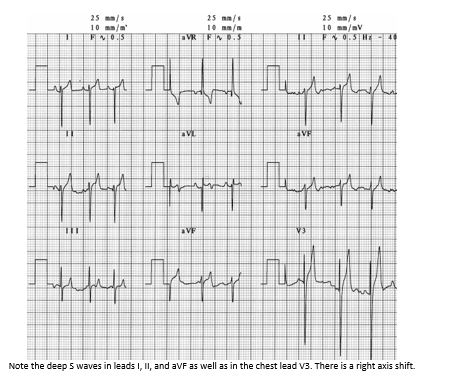
3. Biventricular enlargement/hypertrophy
a. Difficult to diagnose accurately from the ECG
b. Common or characteristic findings –
– prolonged QRS complexes of high amplitude with S-T segment repolarization changes
– deep Q waves in leads I, II and III with QII > 0.5mV
– presence of both right and left atrial enlargement
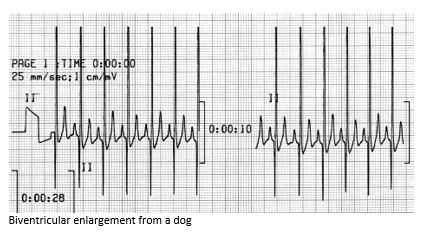
Conduction abnormalities simulating cardiac hypertrophy
1. Left bundle branch block (LBBB) ***
a. Electrocardiographic features
– PII conformation depends on atrial size. May be normal or abnormal.
– P-R interval constant. May be of normal duration or prolonged.
– QRS complexes are inscribed in the expected direction but tend to be of increased amplitude
– Prolonged QRS interval duration – QRSII > 0.08 sec (dog), > 0.06 sec (cat)
– ST-T repolarization changes are usually present. Seen as S-T segment depression in leads I, II, III, aVF, V2 and V4
b. Can be easily confused with marked LV enlargement/hypertrophy (i.e. LVH pattern). Prolongation of the QRS interval to beyond 0.08 seconds dog (0.06 sec cat) is the most important differentiating feature.
c. Almost always associated with heart disease in the dog and cat
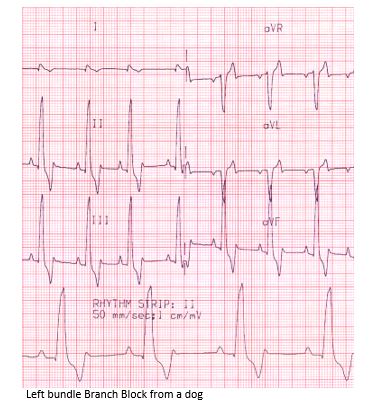
2. Right bundle branch block (RBBB) ***
a. Electrocardiographic features
– PII conformation depends upon atrial size. May be normal or abnormal.
– P-R interval constant. May be of normal duration or prolonged.
– Major QRS complexes are directed to the right (i.e. negative or S waves) in leads I, II, III, aVF, V2 and V4.
– Prolonged QRS interval duration – QRSII > 0.08 sec (dog), > 0.06 sec (cat).
– ST-T repolarization changes are usually present. Seen as S-T segment elevation in leads I, II, III, aVF, V2, V4.
b. Can be confused with marked RV hypertrophy. Prolongation of the QRS interval to beyond 0.08 seconds dog (0.06 sec cat) is the important distinguishing feature.
c. Significance of right bundle branch block is variable. It has been observed in normal dogs as an incidental finding. It has been reported in dogs with right ventricular dilatation, after cardiac trauma and with some congenital heart defects. Intermittent right bundle branch block may occur with some supraventricular tachycardias (aberrant ventricular condition).
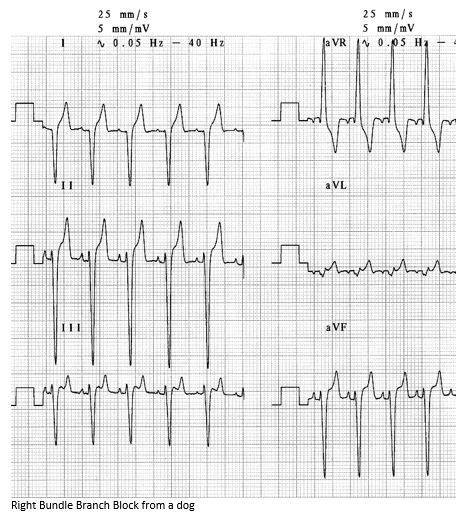
3. Left anterior fascicular block (LAFB)
a. Electrocardiographic features
– PII conformation variable. Depends upon atrial size.
– QRS interval usually of normal duration. If prolongation of the QRS occurs, it usually does not exceed 0.06 sec. (cats).
– Left axis deviation pattern.
-Frontal plane mean electrical axis ranges from -60o to +30o-
-Deep S waves in leads II, III and aVF
-Small Q waves and tall R waves in leads I and aVL
b. Findings overlap with the ECG changes associated with marked left ventricular hypertrophy.
c. Common ECG pattern in cats with hypertrophic cardiomyopathy
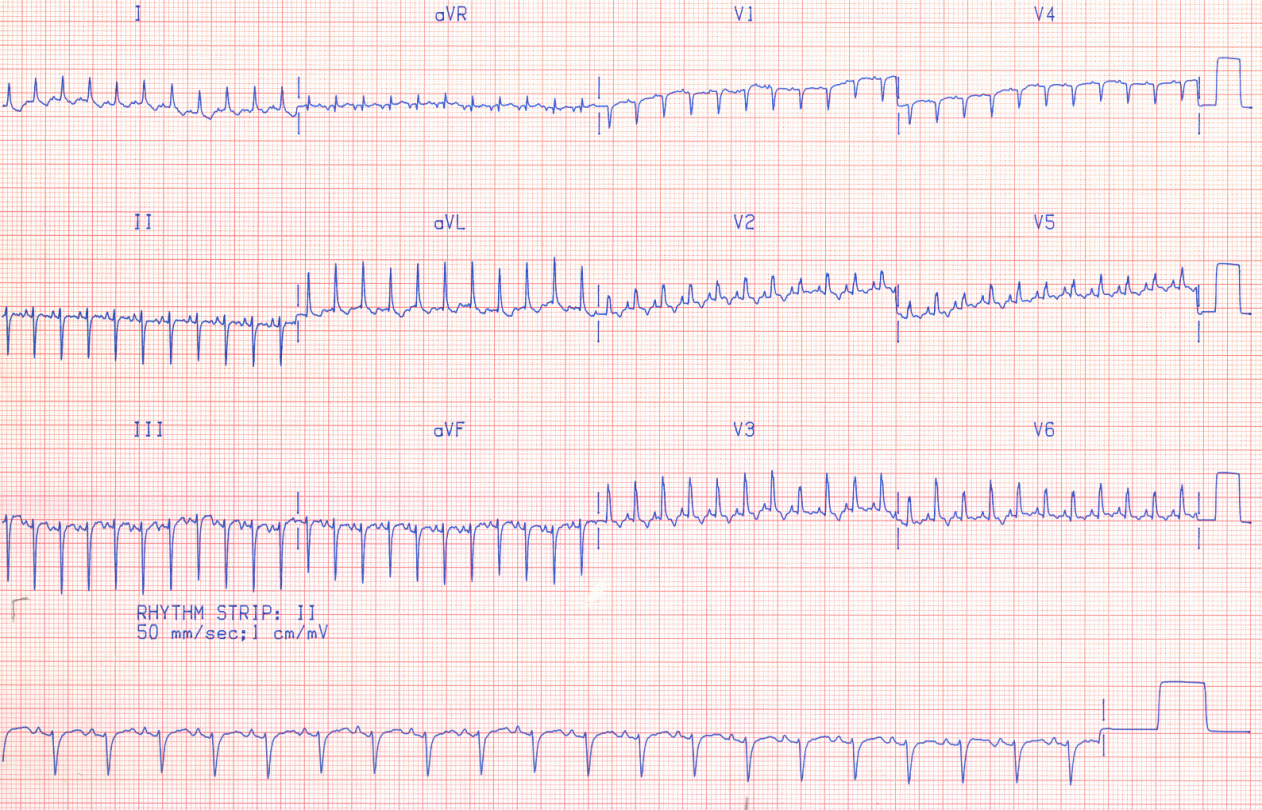
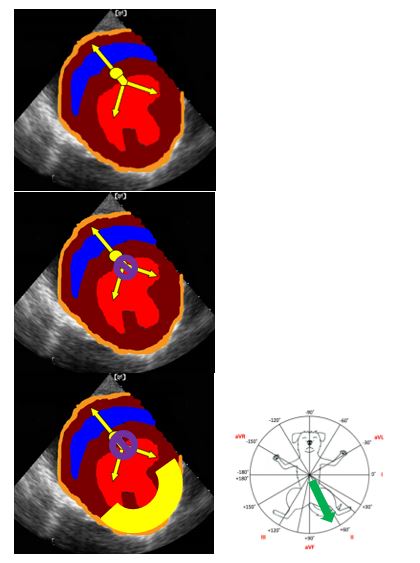
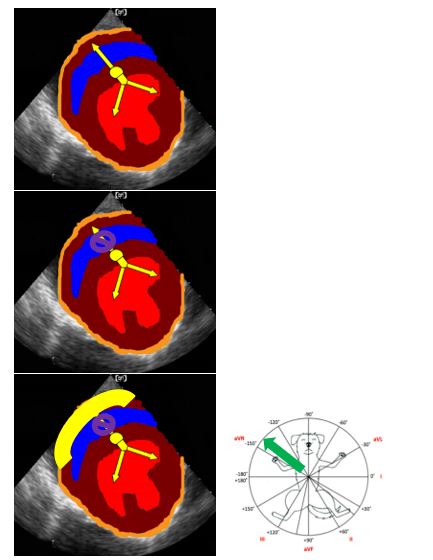
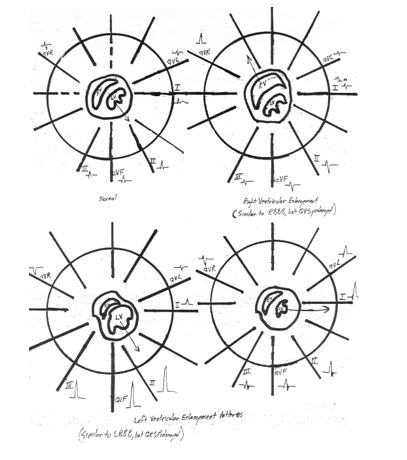
REFERENCES
1. Tilley LP. Essentials of canine and feline electrocardiography, 3rd edition. Lea & Febiger, Philadelphia, 1992.
2. Cote E. Electrocardiography and cardiac arrhythmias. In Ettinger SJ, Feldman EC (eds), Textbook of Veterinary Internal Medicine. Saunders Elsevier, 2010
